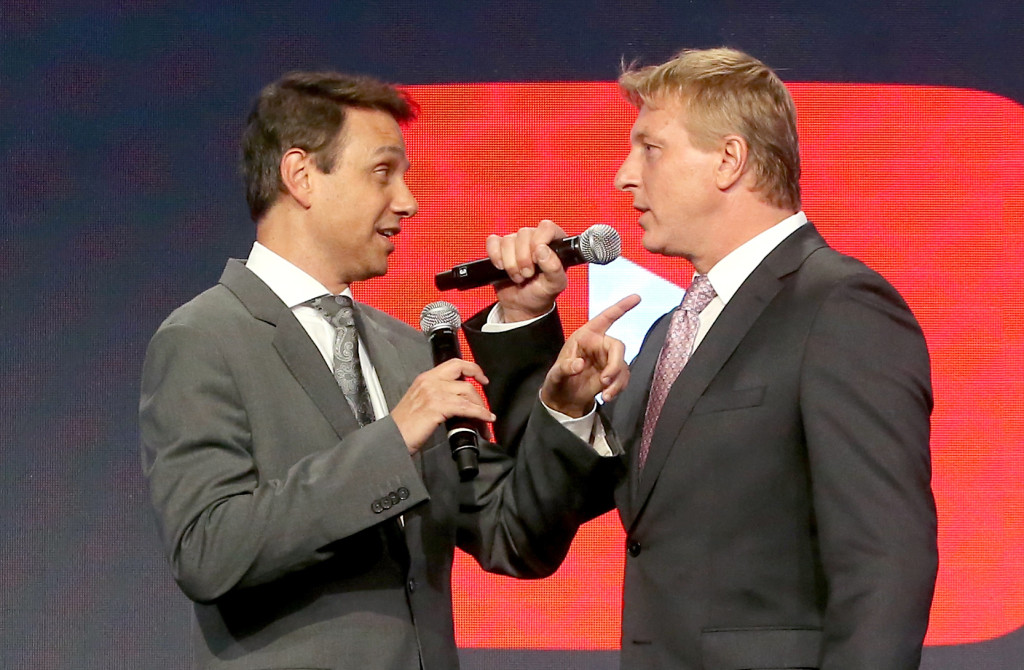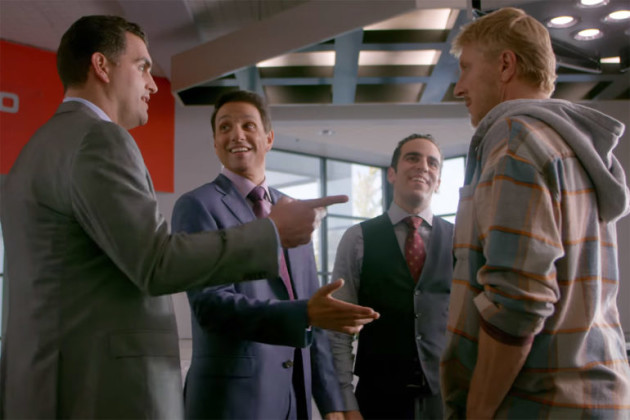With 25 million views (and counting!) for its premiere episode, Cobra Kai has single-handedly made Youtube Red a player in the streaming wars. As Hollywood is an unapologetic copycat league, it’s only a matter of time before we get more rebooted 80s franchises in TV form. But many, if not all of these reboots, will be bad. That’s because Hollywood execs rarely understand why stories work. The only things they understand are what they see on the surface (“Karate is big again!” “80s reboots work!”). Cobra Kai became an out-of-nowhere hit because of some sneaky clever conceptual and execution choices the average schmoe won’t pick up on. Luckily, you’re not the average schmoe. You read Scriptshadow. Which means you’re about to learn some slick screenwriting secrets that should serve you well on your next assignment.
A character on the bottom is more interesting than a character on top – The writers of Cobra Kai understood that if the main storyline came through Daniel LaRusso’s eyes, it would’ve been boring. Most writers would’ve constructed a show where Daniel prepped his daughter to become the next karate kid. That would’ve been dreadful. Instead, the creators saw that Johnny’s life had hit rock bottom, which meant there was a potential for him to rise up. That decision was the single biggest factor in making this show a hit.
Audiences will root for anybody at rock bottom who tries to dig their way out – There isn’t a more likable situation than a character who’s in the gutter but doesn’t give up. Why? Because most people aren’t where they want to be in life. They want more. So when they see someone below them change their circumstances by sheer force of will, they derive hope that they can achieve the same. This is why Johnny, who’s mostly a dick, is so easy to root for. He’s at the bottom but he’s not giving up. He’s determined to rebuild his life.
Never betray who your characters are. They will read false. – These days, TV characters speak as if they’ve been vetted by a studio’s legal team to make sure nobody on the planet is offended by anything they say. It’s become a boring part of television because it’s not real life. In real life, people say bad shit. So when Johnny calls fat kids fat. When he makes fun of a kid with a cleft lip. When he tells kids they’re losers who will never get laid, we feel like we’re finally seeing real life again. You have to stay true to your characters. The second you betray that, the suspension of disbelief is broken.
Use money to keep pressure on your protagonist – One of the oldest cliches in storytelling is lack of money. But it works because everyone can identify with unpaid bills, with scraping by, with trying to get to that next month. If your hero needs money to survive, it creates unresolved conflict within that forces them to be active. A constant tension for Johnny is all the overdue bills for his dojo’s rent and business expenses. We know that if he doesn’t find more students soon, he’ll go belly up. And it works like a charm! We never say, “Oh, that’s so cliche that he doesn’t have enough money.” We buy it because we can relate. This leads us perfectly into our next lesson…
There are two types of cliches, truthful and dishonest – When attempting to navigate cliches, remember that cliches work as long as they’re truthful. If you’re exploring them in an honest way, they’ll work. If you’re slapping them in there without exploring them, they will become dishonest. For example, the absent father is a cliche that’s been around as long as television. But if in each episode you’re trying to explore how the father-son relationship became that way and how it’s affected both parties, and digging into the reasons for how these characters got to this point, it’s going to work. It only doesn’t work when you slap it in there without any exploration whatsoever.
Cobra Kai doubles-down on role reversals – Outside of Johnny being our “hero” this time around and Daniel our “villain,” the writers made this really cool choice to double down on role-reversals. They took good guy teenager Miguel Diaz and paired him with dangerous Johnny. And they took bad guy teenager, Robby, and paired him with angelic Daniel. This made for a more conflict-filled sensei-student relationship and a more nuanced exploration of student and teacher. Cobra Kai would’ve been really boring if Miguel was Daniel’s student.
Conflict is the key to getting mentor-student relationships right – Mentor-Student relationships are everywhere in fiction. The way to get them right is to nail the nature of the relationship’s conflict. In the original Karate Kid, the conflict was in Daniel wanting to go-go-go, learn everything all at once. While Mr. Miagi was all about patience, about letting the teachings come to you. Here in Cobra Kai, Miguel is used to a world where teachers are safe and polite, whereas Johnny’s teachings are aggressive and dangerous. For example, in an early episode, in order to teach Miguel how to kick, Johnny takes him to a local swimming pool, ties his hands together, and kicks him into the deep end. To survive, he’ll need to keep kicking.
Call out the elephant in the room – One of show’s biggest faults is that the core conflict between Johnny and Daniel isn’t believable. They’re really still butting heads over a karate tournament that happened 30 years ago?? When you have an elephant in the room like that, it’s best to call it out. One of the funnier moments in the show is when Johnny comes to Daniel’s house and they get in a yelling match before taking karate stances. Daniel’s wife comes out before punches are thrown. “What are you doing?” she asks. “Give me a second, hon. I have to deal with this.” “Oh sure. As much as I would love to have you and your childhood karate rival duke it out? I kinda don’t want to get any blood on the patio.” A humorous nod to the absurdity of the situation can shift focus away from shaky plot points.
Virtually every character changes during the season – Audiences love character arcs, especially if they’re genuine. We see Miguel turn from a nice guy into a reckless “no prisoners” asshole under Johnny’s tutelage. We see “No Mercy” Johnny question his approach after his student becomes a monster. We see Robby go from a conniving schemer who uses Daniel to get back at his father, to a surrogate son, eager to learn learn everything he can from Daniel. Characters who stay the same are usually boring. You want characters on a path towards someplace different from where they started.
Every character has their own point of view – A common mistake writers make is seeing all of their characters through a singular point-of-view, usually that of the hero. But if you want to find each character’s depth, you have to see them through their own point-of-view. One of the best sequences in Cobra Kai comes during episode 8, when Johnny explains to Miguel why he and Daniel dislike each other. We flash back to scenes from the original movie while Johnny tells him what happened. But this time, we see these moments through Johnny’s point-of-view, not Daniel’s. In this version, Daniel’s not saving Ali from the evil Johnny. He’s taking advantage of Johnny and Ali being in a fight by flirting with her. When Johnny goes to talk to her about it, Daniel “keeps butting in.” So naturally Johnny pushes him away. This isn’t about him. The next thing he knows, Daniel sucker punches him. So of course Johnny has to fight back. Even though Johnny’s recollection of the memory is a bit skewed, it’s clear that HE SAW IT THAT WAY. And that’s what you have to remember about characters, is they all have their view of the past, which is often in conflict with how others remember it. If you can tap into that with each of your characters, you’ll find that they come off much more authentic.



